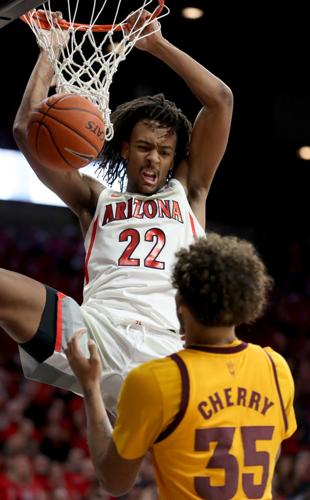Before opponents started double-teaming and throwing other tricks at phenomenally efficient Arizona freshman Zeke Nnaji a few weeks into the college basketball season, there was another element he struggled to contain.
That was, of course, his hair.
It flopped from the top of his head, from the sides, every time he’d take the ball and drive or shoot his way to another basket. Sometimes gravity and forward momentum would keep it away but it was never far from his eyes, or his mind.
It became worse as it grew into November.
“I felt like it was affecting my vision,” Nnaji said. “I had to fix that.”
So before the final game of the Wooden Legacy over Thanksgiving weekend, Nnaji pulled his hair into a ponytail.
No vision problems, nothing flying around… but little production.
Against Wake Forest in that Dec. 1 game, Nnaji was 1 for 5 from the field, scoring five points with eight rebounds. He fouled out after 24 minutes.
“I hadn’t played with the headband before and then it was starting to get a little long,” Nnaji said. “So I put it in the ponytail on but I wasn’t feeling that.”
Certainly, that’s what the numbers suggest. In three games with a ponytail — against Wake Forest, Omaha and Baylor – Nnaji averaged just 8.7 points, 7.0 rebounds and shot just 44.4 percent.
Then he found a compromise.
“I got the headband,” Nnaji continued, “and the headband is, uh, is working.”
Maybe it’s the perfect compromise. His hair still flows, but not into his face.
In three games while wearing a headband — against Gonzaga, St. John’s and ASU – Nnaji is averaging 19.0 points, 13.0 rebounds and shooting 64.5% from the field while hitting 17 of 21 free throws.
Of course, there are probably also some actual basketball-related factors at play here.
For one, Arizona coach Sean Miller has pleaded over and over for his guys to give Nnaji the ball more often, especially instead of taking what he views as ill-advised shots, asking them to run the ball through the post when a clearly good shot doesn’t immediately open up.
In Arizona’s 75-47 win over ASU on Saturday, Nnaji took two more shots than any of his teammates and paid dividends back by hitting 7 of 11 while scoring 17 points and collecting 11 rebounds. He also hit 3 of 4 free throws.
“Not many people have his size, height or strength,” guard Josh Green said, “so a big factor for us guards is getting him the ball.”
Sometimes, Nnaji even rewarded his teammates by drawing defenders, then getting rid of the ball so that it might wind up in the hands of somebody with a better look at the basket.
“The statistics don’t lie ... Zeke produces,” Miller said. “The other thing about him is he doesn’t shoot it every time he catches it. Some of the best opportunities that we had tonight started just with him catching the ball.”
Another factor is Nnaji himself. He’s gotten better at dealing with the sort of defensive attention he’s generated since late November, even if he won’t take much credit for that himself.
“I would get doubled a lot in high school as well,” Nnaji said. “I think that helped a lot because I had to work on that a lot in high school, but we’ve really been doing a lot of different things in practices as well, preparing for those double teams.
“I give credit to my teammates because they know where to find me with the ball in spot and I’m able to hit it back out to them because they know where to go when I get the ball.”
Nnaji’s resumed efficiency wasn’t the only reason the Wildcats had reason to feel better about their frontcourt production against ASU, either.
Freshman center Christian Koloko excelled in an extended opportunity for the second straight game, while UA played reserve forward Stone Gettings for the first time since he suffered a concussion and broken cheekbone on Nov. 29.
Gettings had five points and five rebounds while hitting 1 of 2 3-pointers over 17 minutes, and Miller said Gettings’ return was “awesome” because of the work ethic, intelligence and different style of play he brings.
Koloko also continued to give Arizona a different look in the low post. On Saturday, he blocked two shots while collecting eight points and six rebounds in just 11 minutes.
“You just don’t realize how long, tall (he is) … and he switched a couple of their pick-and-rolls,” Miller said. “And, man, there’s not a lot of 7-footers who can switch onto a guard and not fall down, let alone be adept to challenging the shot and stopping and turning but he’s very well coordinated.
“I know I’ve said this since he’s come here but the best is yet to come, regardless of what he does now. I think he’s future’s incredibly bright, but he helped us tonight, made some really big plays when he was in and like Stone, Christian gives you a little bit of a different look and he’s a shot blocker.
“Our other guys aren’t really shot blockers.”
Koloko played in only eight of UA’s first 12 games, averaging 7.1 minutes in the games when he did play, but has averaged nearly nine minutes a game in the past two.
“Our strategy with Christian is to play him every game,” Miller said. “In some games, I think he’ll have a bigger window than others but we want to make him a part of every game so he gets comfortable.
“In the St John’s game, and in this game, he really helped us.”





